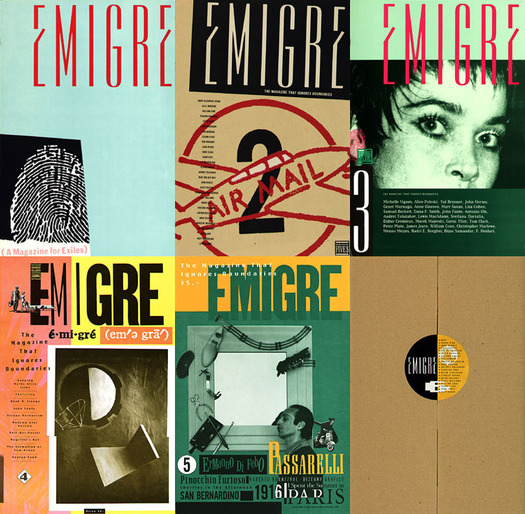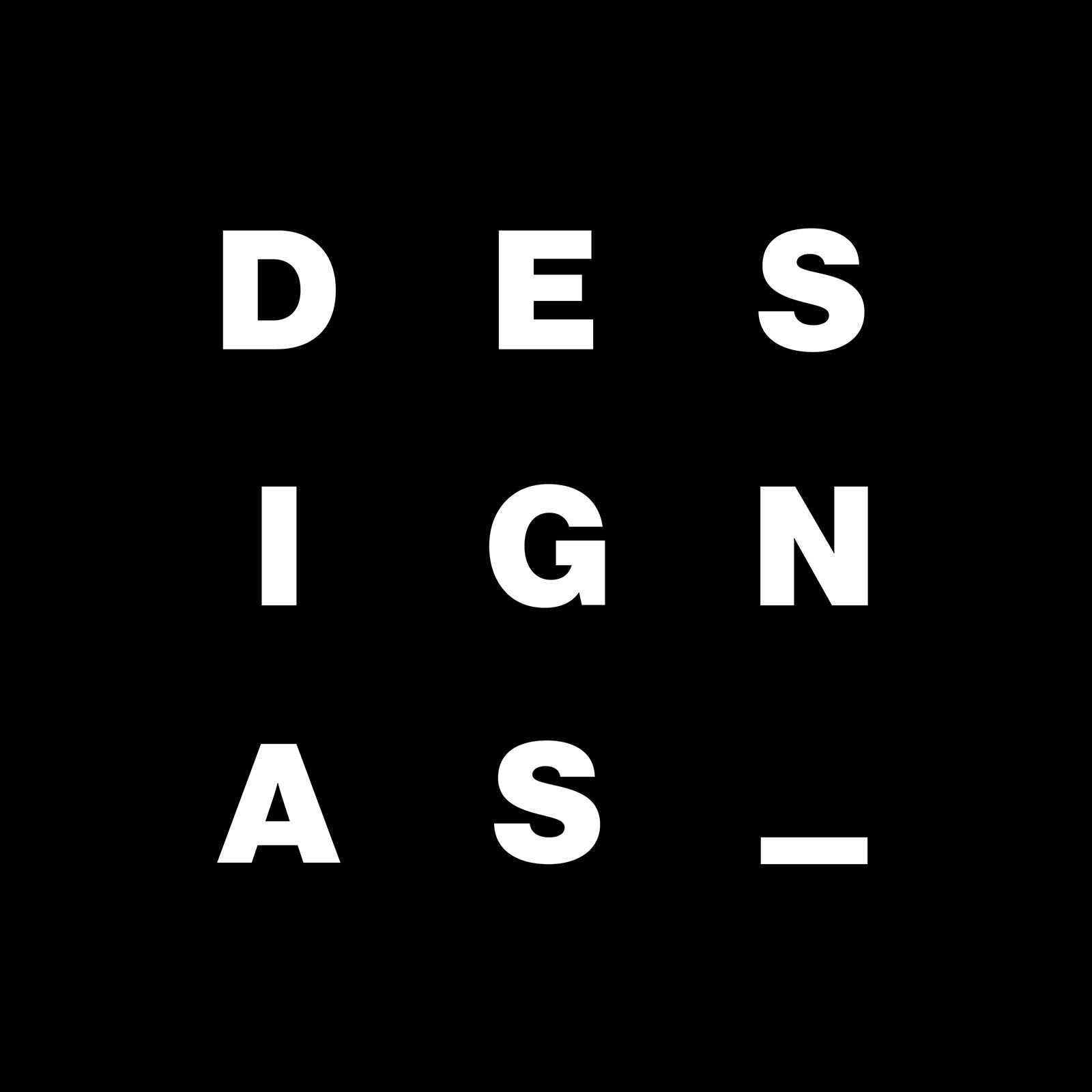
November 10, 2005
Emigre: An Ending

Early issues of Emigre. Source: designishistory.com
So it’s over. One of the great — as in all-time great — design publications has come to a close. Issue 69 of Emigre will be the last. Emigre the type foundry will live on, but founder, editor and designer Rudy VanderLans has commissioned his last article, conducted and transcribed his last interview, and composed his final message to his readers.
And what a treat this message is. VanderLans offers us 69 “short stories”, one for each issue, tracing the development of the magazine from its early days as a “culturetab” through to the final twice-yearly, book-sized issues co-published with Princeton Architectural Press. For admirers of VanderLans’ underrated writing, it is hard to imagine a better send-off. There is a mine of information here that will be an essential first stop for anyone exploring the history of Emigre in future. As a writer, VanderLans has always managed to sound both unassuming and wise. He has exceptionally fine judgement and his prose is highly engaging without being ingratiating or trying to sound like a stand-up guy. He has an ability to ask exactly the right questions that many a full-time journalist might envy.
For me, like many others galvanised by graphic design during Emigre‘s heyday, the magazine was the most consistently interesting design publication produced anywhere by anyone. By 1990, it was one of those magazines you simply had to get hold of and read straight away — back then, in London, that meant a visit to Virgin Records in Oxford Street, of all the unlikely places. VanderLans made no claim to be a journalist, but his ability to focus, like a heat-seeking news missile, on the most significant work, people and ideas was almost uncanny. (Think of all the self-initiated zines and visual culture mags out there and how wide of the mark most of them are, how inessential.) VanderLans would breezily disregard any notion of editorial balance and devote great chunks of an issue, whole issues even, to people barely out of design school, if he believed in the work. By focusing on these subjects, he made them seem important. He brought tremendous confidence and certainty in his own instincts and tastes to everything he did. VanderLans and his rule-bending, postmodernism-embracing, design establishment-snubbing readers would never have used the term, but Emigre radiated authority.
The large-format issues were like no design publication ever seen before. VanderLans conducted long interviews in which he grilled some of the most inventive designers of the day — Vaughan Oliver, Jeffery Keedy, Edward Fella, P. Scott Makela, Designers Republic, David Carson — about every facet of their work. He usually did it first and he often did it best. His page designs were exemplary demonstrations of the new digital design aesthetic, though the inner classicist was never far below the surface, and he lab-tested controversial digital typefaces by his partner Zuzana Licko and other designers championed by Emigre Graphics. As printed objects, these issues are collectors’ items now. As documents, they are essential viewing and reading for anyone who wants to understand how we got to where we are today in graphic design. Buy them while you can. Too bad that some design school libraries failed to subscribe to Emigre while they had the chance, depriving later generations of students of a vital resource.
The same goes for the smaller-format issues introduced in 1995. The writing that VanderLans published over the next few years by designers and design educators such as Jeffery Keedy, Andrew Blauvelt, Lorraine Wild and Kenneth FitzGerald did much to set the intellectual pace in design criticism and anyone concerned with such matters should consult back issues from this period. Sometimes the essays became hopelessly self-indulgent and you wanted to shake the writer and yell “get a grip”, but you had to admire VanderLans’ willingness to take a chance on people and it paid off with pieces that could never have appeared anywhere else. Keedy stands out as the quintessential Emigre insider: knowledgeable, dedicated and waspish; part sensitive type scholar, part hatchet man; a postmodern proselytiser who was always ready to turn a jet of withering scorn on modernist backsliders. (He suspected I was one of them, but Mr K, I was a swing-several-ways pluralist all along.) The feeling that something was actually at stake made it compelling and the feuds were part of the fun. Vignelli calls Emigre a factory of garbage! Heller laments the sheer ugliness of it all in Eye! Emigre retaliates with a series of interviews with Heller and the offended parties! Blauvelt gives Heller a good kicking to make sure the job is well and truly done! Kinross fires off a 32-page pamphlet setting everyone straight! Keedy names and shames the zombie modernists (again)!
It has been obvious since the short-lived switch in 2001 to CDs in wallets that Emigre was running out of steam. VanderLans appeared to have lost his earlier zest for design discussion. The paperbacks were a return to something resembling the old form, though minus the visual thrill, but as he notes with his customary frankness in the last issue, sales fell. A lot of the writing seemed to repeat what had already been said, or to sound a note of dismay for the supposed demise of discourse. In the background, too, as VanderLans makes clear, was the rise of the blogs. Emigre used to receive a remarkable quantity of impassioned mail and he could sometimes fill half an issue with it. But when it comes to feedback, nothing can match the speed and ease of the comment box and the chance to interact.
Design blogs generate a lot of noise and they sure do love their own hype, but nothing produced in this area has so far equalled the concentrated documentary achievement and design culture transforming impact of Emigre and if you doubt this, just go and look at the magazine. Emigre had a clearly defined purpose. It involved contributions by many talented people, but the conduit for all this fervour and brain power was provided by one unusually astute editor. Emigre emerged at a time when technology was changing design forever and the magazine sizzled with this energy and excitement. Nothing so momentous or contentious is happening in graphic design today. Blogs, on the other hand, lack the focus of an overriding design mission. They are places for chatter. They are about anything, everything and often about nothing of any great consequence. No one, so far, has used the medium to stake out an urgent critical position comparable to Keedy’s or Blauvelt’s in the pages of Emigre in the 1990s. Nor have blogs proved to be the medium for exploring new design aesthetics. In Emigre, form itself became a means of debate. What the magazine said was inseparable from how it looked.
Emigre is somewhat neglected now. It has fallen out of fashion as it was bound to and it is too close to view it with total clarity. In time, the magazine and the fertile, idea-packed design culture it represented will be studied with the kind of attention given to 1920s modernism and it will be seen for what it was — one of the watershed contributions to 20th-century typography and graphic design.
When this essay was first posted, a note at the end announced that I was leaving Design Observer, hence some of the comments below. I later resumed writing for the site and removed this note.
Observed
View all
Observed
By Rick Poynor
Related Posts

Arts + Culture
Nila Rezaei|Essays
“Dear mother, I made us a seat”: a Mother’s Day tribute to the women of Iran

The Observatory
Ellen McGirt|Books
Parable of the Redesigner

Arts + Culture
Jessica Helfand|Essays
Véronique Vienne : A Remembrance

Design As
Lee Moreau|Audio
Announcing: Design As Season Two
Recent Posts
“Dear mother, I made us a seat”: a Mother’s Day tribute to the women of Iran A quieter place: Sound designer Eddie Gandelman on composing a future that allows us to hear ourselves think It’s Not Easy Bein’ Green: ‘Wicked’ spells for struggle and solidarity Making Space: Jon M. Chu on Designing Your Own PathRelated Posts

Arts + Culture
Nila Rezaei|Essays
“Dear mother, I made us a seat”: a Mother’s Day tribute to the women of Iran

The Observatory
Ellen McGirt|Books
Parable of the Redesigner

Arts + Culture
Jessica Helfand|Essays
Véronique Vienne : A Remembrance

Design As
Lee Moreau|Audio

 Rick Poynor is a writer, critic, lecturer and curator, specialising in design, media, photography and visual culture. He founded Eye, co-founded Design Observer, and contributes columns to Eye and Print. His latest book is Uncanny: Surrealism and Graphic Design.
Rick Poynor is a writer, critic, lecturer and curator, specialising in design, media, photography and visual culture. He founded Eye, co-founded Design Observer, and contributes columns to Eye and Print. His latest book is Uncanny: Surrealism and Graphic Design.